
Ithaca, Ithaki or Ithaka is a Greek island located in the Ionian Sea, off the northeast coast of Kefalonia and to the west of continental Greece.
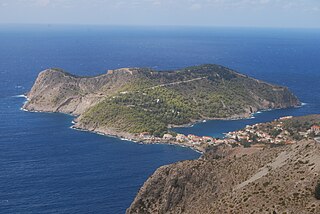
Kefalonia or Cephalonia, formerly also known as Kefallinia or Kephallenia (Κεφαλληνία), is the largest of the Ionian Islands in western Greece and the 6th largest island in Greece after Crete, Euboea, Lesbos, Rhodes and Chios. It is also a separate regional unit of the Ionian Islands region. It was a former Latin Catholic diocese Kefalonia–Zakynthos (Cefalonia–Zante) and short-lived titular see as just Kefalonia. The capital city of Cephalonia is Argostoli.

Lefkada, also known as Lefkas or Leukas and Leucadia, is a Greek island in the Ionian Sea on the west coast of Greece, connected to the mainland by a long causeway and floating bridge. The principal town of the island and seat of the municipality is Lefkada. It is situated on the northern part of the island, approximately 25 minutes by automobile away from Aktion National Airport. The island is part of the regional unit of Lefkada.
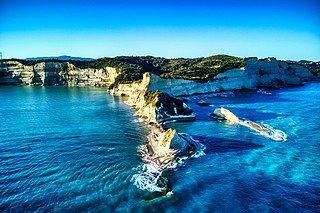
The Ionian Islands are a group of islands in the Ionian Sea, west of mainland Greece. They are traditionally called the Heptanese, but the group includes many smaller islands in addition to the seven principal ones.

Karpathos, also Carpathos, is the second largest of the Greek Dodecanese islands, in the southeastern Aegean Sea. Together with the neighboring smaller Saria Island it forms the municipality of Karpathos, which is part of the regional unit Karpathos-Kasos. Because of its remote location, Karpathos has preserved many peculiarities of dress, customs and dialect, the last resembling those of Crete and Cyprus. The island has also been called Carpathus in Latin and Scarpanto in Italian.
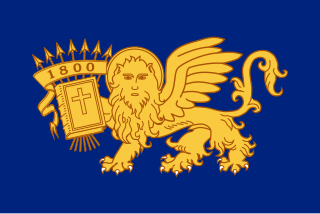
The Septinsular Republic was an oligarchic republic that existed from 1800 to 1807 under nominal Russian and Ottoman sovereignty in the Ionian Islands.
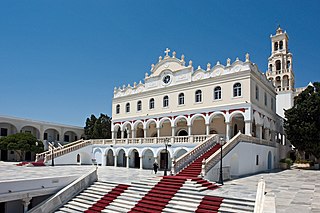
Tinos is a Greek island situated in the Aegean Sea. It is part of the Cyclades archipelago. The closest islands are Andros, Delos, and Mykonos. It has a land area of 194.464 square kilometres (75.083 sq mi) and a 2021 census population of 8,934 inhabitants.
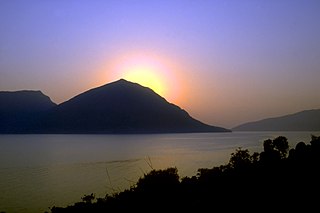
Kálamos is a mountainous island and a former community in the Ionian Islands, Greece. Since the 2011 local government reform it is part of the municipality Lefkada, of which it is a municipal unit. It lies east of Lefkada, near the Greek mainland. It has a wintering population of around 500 people, which is swelled substantially in the summer by tourists. The name Kalamos means reed in Greek and the presence of this plant along its coastline in the past may have given its name. Another version is that the island had several beaches with good sand hence the name given. The land area is 24.964 km2 (9.639 sq mi), and its highest point is 754 m (2,474 ft) above sea level.

Lefkada City is a city and a former municipality on the island of Lefkada, Ionian Islands, Greece. Since the 2011 local government reform it is part of the municipality Lefkada, of which it is a municipal unit. It is the capital and main town of the island of Lefkada, located in the northern and northeastern part of the island. The city had a population of 9,253 inhabitants at the 2021 census. The municipal unit has a land area of 60.628 square kilometres (23.409 sq mi) and a population of 13,540 (2021).
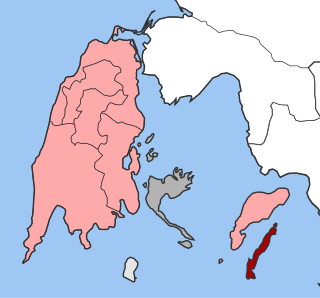
Kastos is a Greek island and a former community east of the island of Lefkada, Ionian Islands, Greece. Since the 2011 local government reform it is part of the municipality Lefkada, of which it is a municipal unit. Until 1974, when it became part of the Lefkada Prefecture, the island was administered under the Cephalonia Prefecture. The nearest island is Kalamos, with a deep channel between them; the mainland is approximately 5 kilometres to the northeast in Aetolia-Acarnania.
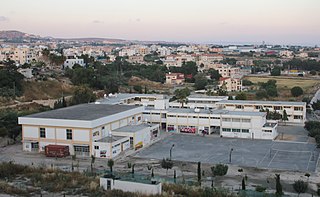
Geroskipou is a coastal village in Cyprus, east of Paphos. Its current population is approximately 7,000 and it is the second largest municipality in the Paphos District. Yeroskipou, with its remarkable five-domed Byzantine church of Agia Paraskevi, and its Folk Art Museum, is a popular tourist destination. It is known especially for the production of the confectionery "lokum". The town is the only place in the world which has protected geographical indication (PGI) for the popular dessert.
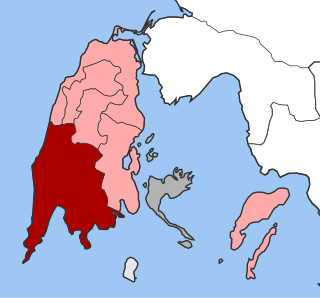
Apollonioi is a former municipality on the island of Lefkada, Ionian Islands, Greece. Since the 2011 local government reform it is part of the municipality Lefkada, of which it is a municipal unit. It is located in the southwestern part of the island. Its population was 2,389 at the 2021 census. The seat of the municipality was in Vasiliki. Its area is 124.709 km2, comprising about 41 percent of Lefkada Island. The area features beautiful beaches on the western side of the island, the most famous are in Porto Katsiki and in Ekremnoi. The Porto Katsiki Beach has been voted the second best beach in the world.

Pyli is a municipality in the Trikala regional unit, Greece. Situated 18 km west of Trikala, right at the bottom of two mountains Itamos, and Koziakas, which mark the beginning of the Pindos mountainline, Pyli marks the entrance to a great gorge and the natural path that leads to the city of Arta. The river Portaikos, a tributary of the river Pineios, runs through this location. The municipality of Pyli contains 7 municipal units, but the town itself has a population of about 2,000. Most inhabitants are either self-employed in business establishments. Agriculture and animal herding as an occupation has been largely abandoned, though the surrounding area is ideal for both. Pyli had always been the major trade center for the surrounding settlements.
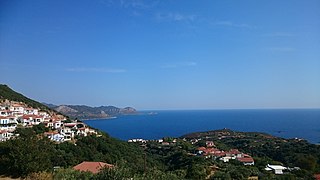
Velanidia is a village and a community in Laconia, Greece, within the municipality of Monemvasia. It is situated at the southern edge of Peloponnese at the southeast edge of mountain range Parnon. It includes several Byzantine churches, giving it the nickname Small Agios Oros. This village is near Cape Maleas. Population 368 (2021).
Marantochori is a small, quiet village in the southern part of the island of Lefkada, Greece. Almost all of the village is made up of farmers. It is one of the few places in Lefkada that does not have a view of the sea from any point.

Alona is a village in the Nicosia District of Cyprus. It located on the north side of the Troodos peaks between Madari and Papoutsa mountain ranges at an altitude of 1200 meters.

Nikolaos Doxaras. He was a Greek painter and teacher. His father was famous painter Panagiotis Doxaras. Panagiotis Doxaras was the father of the Greek Rococo and the Modern Greek Enlightenment in art. They are both prominent members of the Heptanese School. They refined Greek art bringing the Maniera Greca into the Maniera Italiana. Artists he influenced include: Nikolaos Kantounis, Nikolaos Koutouzis and Gerasimos Pitsamanos. His influence can be seen in some of Nikolaos Kantounis's paintings notably The Assumption. Nikolaos taught famous painter Nikolaos Koutouzis. Both Nikolaos Koutouzis and Doxaras artistic style refined the art of the Ionian Islands. Venetian painting influenced countless Greek artists who were living in the empire. From Michael Damaskinos to Theodore Poulakis. Twenty years after Nikolaos's death the style came to an end due to the Fall of the Republic of Venice. A new artistic style developed after the Greek Rococo which coincided with Neoclassicism in the rest of Europe called the middle Modern Greek Enlightenment in art also known as Neo-Hellenikos Diafotismos.

The First period of French rule in the Ionian Islands lasted from June 1797 to March 1799. Following the fall of the Republic of Venice in May 1797, the Ionian Islands, a Venetian possession, were occupied by Revolutionary France. The French instituted a new, democratic regime and, following the Treaty of Campo Formio, annexed the islands to France, forming the three departments of Corcyre (Corfu), Ithaque (Ithaca) and Mer-Égée.

The Ionian Islands were an overseas possession of the Republic of Venice from the mid-14th century until the late 18th century. The conquest of the islands took place gradually. The first to be acquired was Cythera and the neighboring islet of Anticythera, indirectly in 1238 and directly after 1363. In 1386 the Council of Corfu, which was the governing body of the island, voted to make Corfu a vassal of Venice. During the Venetian period the Council remained the most powerful institution on the island. A century later, Venice captured Zante in 1485, Cephalonia in 1500 and Ithaca in 1503. These three islands modelled their administration on Corfu's model and formed their own councils. The conquest was completed in 1718 with the capture of Lefkada. Each of the islands remained part of the Venetian Stato da Màr until Napoleon Bonaparte dissolved the Republic of Venice in 1797. The Ionian Islands are situated in the Ionian Sea, off the west coast of Greece. Cythera, the southernmost, is just off the southern tip of the Peloponnese and Corfu, the northernmost, is located at the entrance of the Adriatic Sea. It is believed that the Venetian period on the Ionian Islands was generally prosperous, especially compared with the coinciding Tourkokratia — Turkish rule over the remainder of present-day Greece.
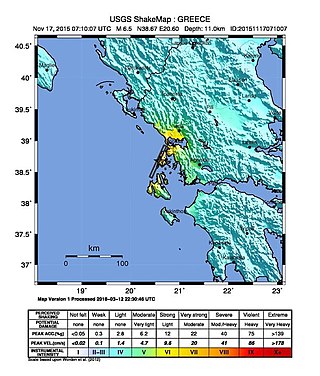
The 2015 Lefkada earthquake occurred on November 17, 2015, 10:40:07 (EEST) with a moment magnitude of 6.5 located 19 km Southwest of the Greek island of Lefkada along with a depth of 11 km and intensities reaching as high as VIII (Severe) on the Modified Mercalli Scale. Two people lost their lives in the event and 4–8 others were hospitalized with injuries.



















